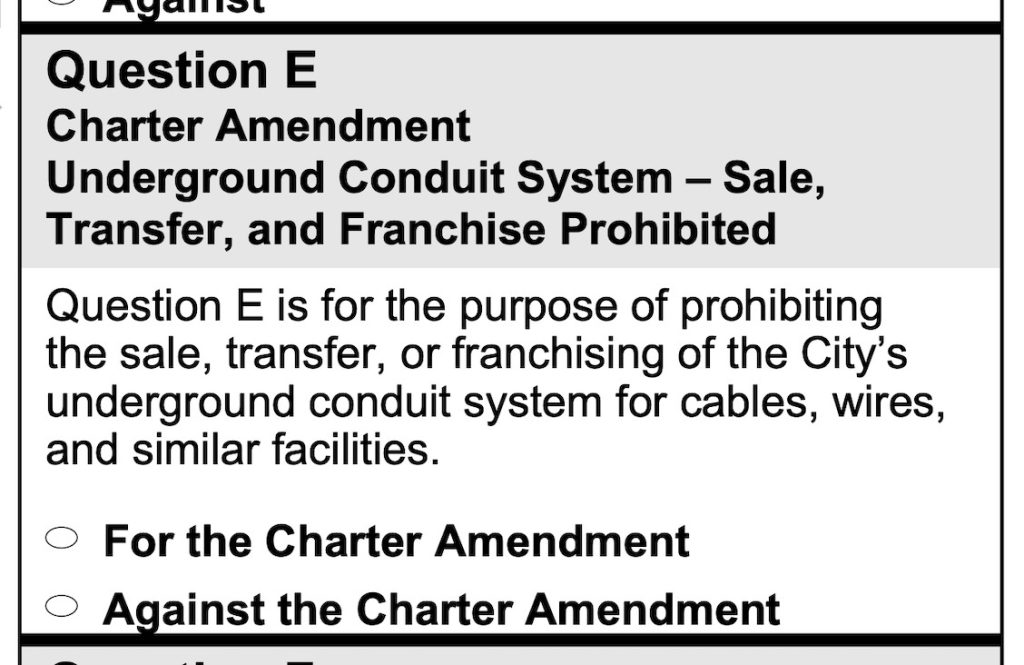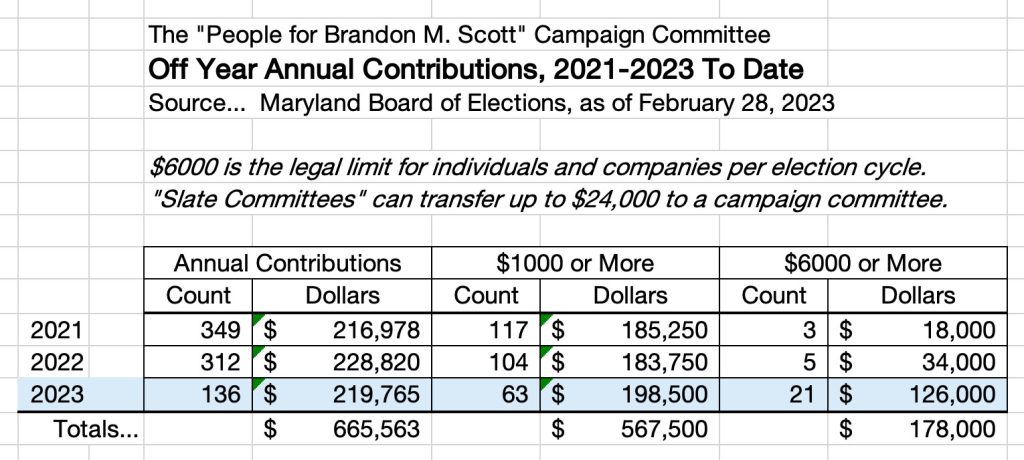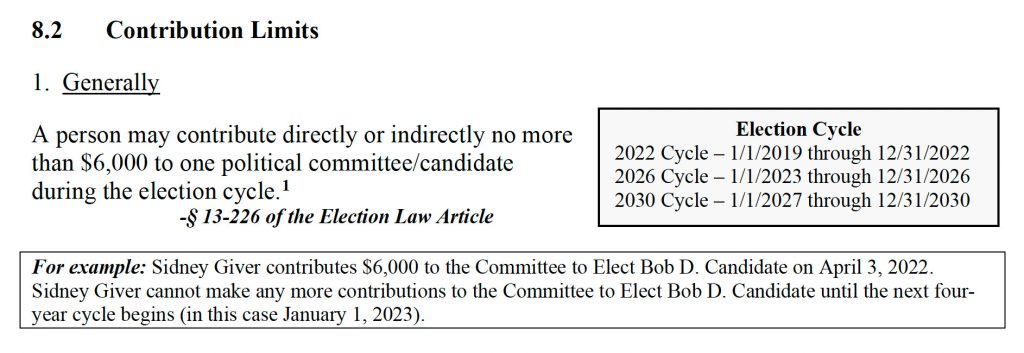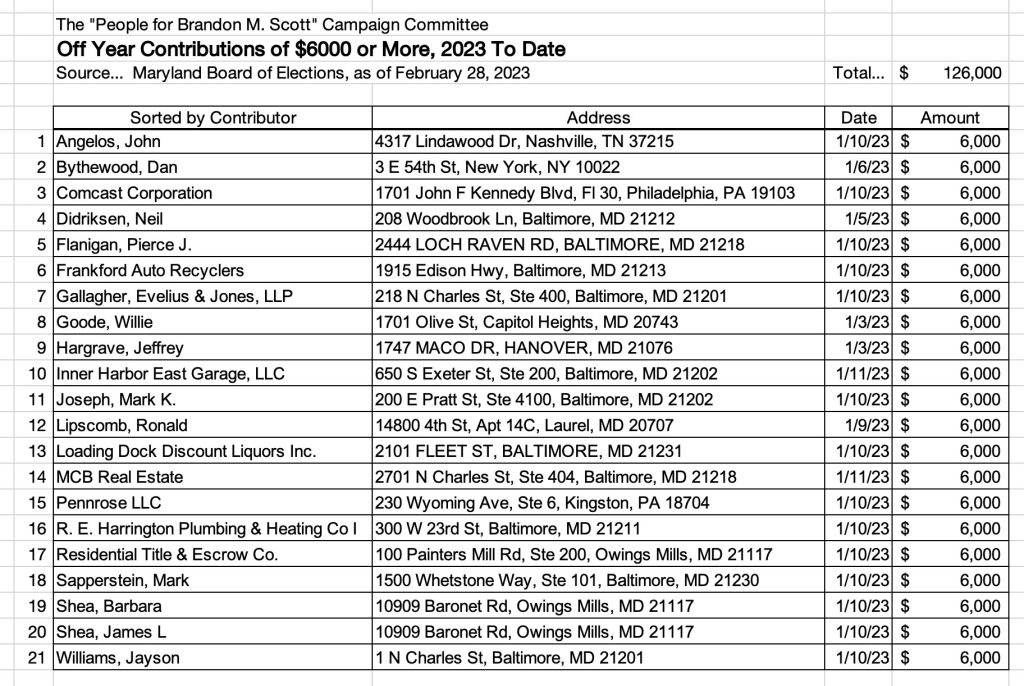Missing the Point – Off-Year Contributions to Mayor Scott’s Campaign Committee Raise Red Flags
This op/ed is about the timing and sources of off-year campaign contributions to “The People for Brandon M. Scott.” What do the optics of these contributions suggest? Are the contributions we’re going to talk about nothing more than people and companies interested in supporting good government? Or are they effectively payments by special interests in return for favorable treatment by the candidate they are funding?
For the record, I’m not going to make any claims as to the appropriateness or legality of the contributions we talk about. I don’t like money in politics, but contributions made according to the laws controlling campaign financing are, by definition, perfectly legal. I’m just going to give you information to stimulate discussion about campaign financing and let you draw your own conclusions. My objective is to encourage enforcement and changes to the law that reduce the influence money may have on who we elect and how our elected officials behave in office.
Note also that the contributions data I’m going to show you is publicly and readily available from the “Campaign Finance” section of the Maryland Board of Elections website. I may present these data differently than in tables published by the Board of Elections, but the data itself is in its original form as reported by the campaign committees to the Board.
So why talk about campaign contributions now, more than a year from the next primary election for the office of Mayor of Baltimore? What, if anything, has happened involving the current Mayor that suggested that I check contributions to Mayor Scott’s campaign committee?
As you have no doubt heard by now, Mayor Scott has recently negotiated the sale of the city’s conduit system to BG&E. The economics of the sale are somewhat complex and I don’t pretend to understand the various pros and cons of what he’s doing except to say that it’s important business for the city that clearly deserves careful consideration. In any case, this op/ed isn’t about the implications of such a sale. It’s about the coincidental optics of contributions to Scott’s campaign committee.
What got my attention was the way Scott went about his negotiations with BG&E. As I understand the situation, when Scott was President of the City Council, he favored Council action that eventually resulted in Question E on the 2022 Baltimore City ballot. The Council was so concerned that the city’s conduit system might be sold, it voted for a ballot question to amend the city charter to prevent such a sale. The screenshot below is from the ballot published by the Board of Elections and shows the question posed to voters in last year’s general election…

The results were 94,708 voters in favor of the charter amendment, and 28,826 against it. More than three-quarters of the people voting opposed the sale of the city’s conduit system. And that should have been that. But it wasn’t and that’s what bothered me.
Despite having been personally opposed to selling the conduit when he was President of the City Council… And despite knowing full well that selling the conduit is in conflict with the City Charter as amended by the results of voting for Question E last year, Mayor Scott has made no real effort to involve the City Council in his negotiations with BG&E. Why not? Certainly, he has every right to change his mind, but he has no right to ignore the will of the people of Baltimore as expressed in last year’s general election.
And so, I was curious and checked the campaign contributions his committee had been receiving lately.
“That’s where you went? From reading a few articles to wondering about his campaign contributions?”
Fair question. My problem is that I’ve been around for a while and have worked a fair amount in politics. It’s made me cynical. I’d try harder to get over it except that, more often than not, my skepticism has proven to be well-founded. As for this particular foray into campaign contributions, here’s what I discovered…
I have three tables to show you. This first table presents annual contributions for 2021, and 2022, and the first two months of this year, 2023. I downloaded these contributions data a couple of weeks ago on February 28. What these three years have in common is that they are “off years” during which the Mayor is not running for office. The next primary and general election will not happen until 2024. As a rule, unannounced candidates do not get significant campaign contributions during years when they’re not running for anything.

Notice how similar the total annual contributions are for each of the three years – except that, if I were to show you the monthly data, 100% of 2023’s contributions occurred in January. Nothing in February. $219,765 in just one month – the first month of the new election cycle.
As you can see from the screenshot below from Chapter 8 of the “Summary Guide to Maryland Candidacy and Campaign Finance Laws,” the previous election cycle ran from January 1, 2019, through December 31, 2022. January 1, 2023, is the start of the new, 2026 election cycle. (The boxes drawn around the text in the screenshot are in the original document.)

The legal limit for campaign contributions by an individual (or company) is $6000 for a given candidate. That’s not an annual limit. The legal limit is $6000 for a single candidate, in total, over the entire four-year election cycle.
“So why would someone or a company contribute to a campaign committee, particularly for an unannounced candidate, during an off year?”
Good question. The usual reason, particularly for larger contributions of, let’s say, $1000 or more, is access to the candidate. In Mayor Scott’s case, we’re talking about access to the sitting Mayor of the City of Baltimore. The contribution is to make sure he picks up the phone when you call him and pays attention to what you may ask him to do for you. Because campaign contributions are, effectively, a form of “paying” an official for favors he might do for you. …And now you know why I want to get money out of elections.
Note, in particular, the 21 contributions of the maximum $6000 – all of them in January. Those 21 contributors can’t contribute any more to the Scott campaign until January 1, 2027, when the next, 2030 election cycle gets underway. That’s 21 maximum contributions compared to just three in all of 2021 and only five in all of 2022.
“Hmm.”
Yeah. So, I asked myself, what was happening in and about January of this year that might have encouraged these contributions? Well, lots of things, not the least of which were negotiations between Mayor Scott and BG&E for the sale of the city’s conduit system.
More specifically, here is a list of the 21 people and companies who contributed the legal maximum of $6,000 to Mayor Scott’s campaign in January. If you have the time, you might Google these contributors to see who they are.

The two Shea contributions on lines 19 and 20 – from the same address – are related to James Shea, former Chairman of Venable law, former Democratic Candidate who ran for Governor with Brandon Scott as his running mate in 2018 and was later appointed City Solicitor by newly elected Mayor Scott. Shea has since been replaced as City Solicitor by Ebony Thompson, a lawyer and former Associate at Venable from 2013 until 2022 according to her LinkedIn page. Do you know what law firm has represented BG&E as one of its several outside counsels and is very much interested in developing its energy sector business? Venable.
“First Shea and then Thompson, both from Venable. Were there no other attorneys Mayor Scott might have hired for City Solicitor to replace Mr. Shea, from legal practices with no potential conflicts of interest?”
Apparently not.
“So, let me get this straight… The City Solicitor who has been representing Baltimore in Mayor Scott’s negotiations with BG&E for the sale of the city’s conduit system – which the people of Baltimore have voted against doing – has long-standing and possibly continuing relationships with one of the law firms that represent BG&E?”
Yes. For example, Venable, which is the law firm we’re talking about, has partner-level experience representing BG&E’s parent company, Exelon, when it merged with Pepco a few years ago. So, yes. Those are the optics. The question is, are these relationships and contributions nothing more than superficially coincidental or are they indicative of relationships that should be of concern to the people of Baltimore?
During the off years we’ve been talking about, Mayor Scott’s campaign committee has raised $567,500 from 284 contributions of $1,000 or more made by people and companies. You can use the link below to see who made these contributions which are sorted by address. Sorting contributions by address helps us identify related contributions that may have been made by different people and companies. Needless to say, some contributors are more influential than their individual contributions might otherwise suggest by virtue of how they are able “encourage” contributions from family, friends, and companies which they manage, own, or affect by virtue of the business they do with them.
Within groups of related contributions, I’ve sorted those contributions by date to see in which election cycles contributions were made. Remember, the limit is $6000 per election cycle as defined by the Board of Elections. The dates may also help interested voters understand the timing of contributions relative to which the Mayor may be considering this or that related to a given contributor.
In the course of generating this table, I found two instances of contributions that appear to be in excess of the legal maximum…
05 Brandon Scott Campaign Contributions of $1000 or More, 2021-2023 – Feb 28, 2023


In the first case, the contributor was reported by the campaign committee as having contributed a total of $8500 during 2021 and 2022, both years of which are in the same election cycle. The fourth contribution by this same contributor occurred in 2023 at the start of a new election cycle. In the second case, the 2021 and 2022 total contributions totaled $8,000.
You would think that Board of Elections software could be coded to identify contributions that exceeded the legal limit and flag them for review by Board of Elections staff.
Any comments and suggestions you may have will be greatly appreciated.

Les Cohen is a long-term Marylander, having grown up in Annapolis. Professionally, he writes and edits materials for business and political clients from his base of operations in Columbia, Maryland. He has a Ph.D. in Urban and Regional Economics. Leave a comment or feel free to send him an email to [email protected].

